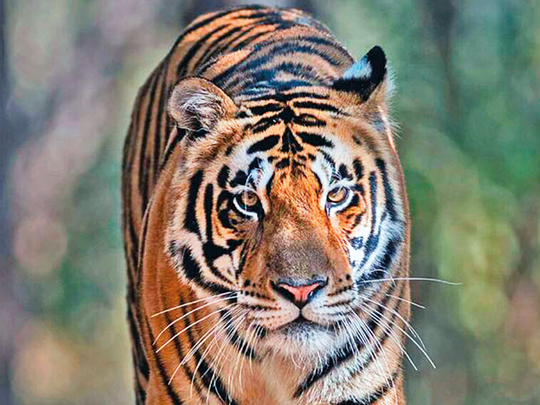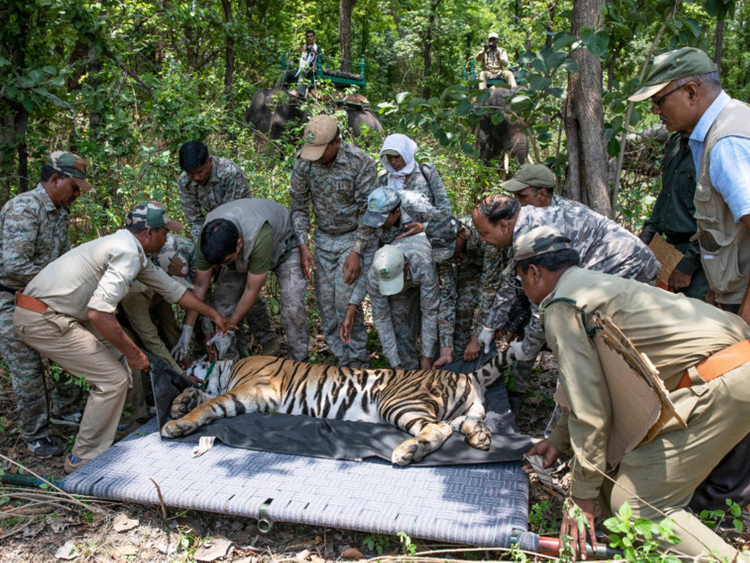
For the first time in India, the inter-state transfer of tigers took place in June this year. A male tiger was the first one to be relocated to the Satkosia Tiger Reserve in Odisha’s Angul district from the central Indian state of Madhya Pradesh followed by a female a few days later.
While the male was brought from Kanha Tiger Reserve (TR), the female arrived from the Bandhavgarh TR of the central state. The male has already been released into the wild and the female is likely to be released shortly. The female is currently kept in a special enclosure and is being monitored prior to its planned release. Two more tiger pairs are likely to be brought to Satkosia in phases.
The tiger re-introduction plan was finalised last year and Madhya Pradesh had agreed to provide three pairs of big cats for Satkosia. It was decided to bring one pair each from Kanha, Pench and Bandhavgarh reserves.
Relocating the tigers is part of an ambitious project to repopulate Satkosia’s lush forests with the big cat. Only three female tigers survive in Satkosia and all are over 13 years old.
Odisha has two notified tiger reserves. The first, Similipal TR, was notified in 1973 soon after the launch of Project Tiger. Satkosia was declared as tiger reserve much later in 2007 but it has reached the brink of becoming tiger-less and is now a tiger reserve in name only with only three ageing females left. Satkosia is one of the best ecosystems in the country, representing a diverse floral and fauna. The reserve has an area of 964 sq km with 524 sq km as core area and is contiguous to vast tiger landscapes of northern and southern Odisha.
Odisha is a low-density tiger habitat in the country with only 40 big cats left in the eastern state according to 2016 tiger census.
Simlipal TR is the home of 26 of the 40 surviving big cats. Tigers from other wildlife habitats and forest areas of the state have practically vanished. According to experts, tiger population plummeted across the state, including Satkosia, due to insufficient protection measures, widespread poaching, degradation of habitat and increasing human pressure. Odisha had 192 tigers according to 2004 census.
In such a grim scenario, both the Odisha government and the National Tiger Conservation Authority (NTCA), the country’s apex government agency for the protection of the big cats, are keen to repopulate Satkosia and the officials and the wildlife experts prepared a plan to reintroduce big cats in the reserve.
While the intra-state tiger relocation has been very successful in the past in Madhya Pradesh as well as in the north-western desert state of Rajasthan, this was the first inter-state relocation.
Tiger conservationist and wildlife campaigner Belinda Wright said, “Satkosia is a beautiful tiger habitat. I hope they will take every measure to keep them safe in Satkosia.”
Wright, who is the founder and executive director of Wildlife Protection Society of India, said it is the first ever inter-state re-introduction of tigers in the country’s conservation history. She said moving of the big cats is a feasible idea as long as they don’t move breeding animals.
Sanjay Kumar Shukla, Chief Conservator of Forests and Field Director, Kanha Tiger Reserve, described how the relocation was accomplished. He said this was the first time in the country that tigers from a protected area had been sent to another state for re-introduction. He expressed hope that the tigers that were moved and those to be relocated in the future would help establish a good population of big cats at Satkosia and Odisha government’s plan to revive the big cat population in the state would be successful.
Wildlife enthusiasts and government authorities are encouraged by the success of similar experiments in Rajasthan’s Sariska Tiger Reserve in 2008 and Madhya Pradesh’s Panna Reserve in 2010. Wildlife experts are making use of the scientific and management skills gained from the successful tiger relocation exercises at these places. Panna had lost all its tigers but today it has 30. Similarly, Sariska also lost all its big cats to poaching and eight tigers were relocated from Ranthambore Tiger Reserve to Sariska between 2008 and 2012. The relocated big cats have been successfully breeding at Panna and Sariska and several cubs have been born in the recent years.
Though the relocation experiment was successful at Panna and Sariska, the re-introduced tigers continue to face usual threats that all big cats face in India. In November 2010, the first relocated tiger died due to poisoning in Sariska. Another big cat was poached in March this year. Yet another relocated tiger is reported to be missing.
The male tiger from Kanha Tiger Reserve and the female from Bandhavgarh have been doing well and appear to have settled down at Satkosia.
Odisha Chief Minister Naveen Patnaik said history had been created in tiger conservation efforts in India. In a tweet, he congratulated Odisha Forest Department and Kanha and Bandhavgarh tiger reserves on successful translocation. He said six tigers, three males and three females, are to be brought to Satkosia.
Odisha’s Forest and Environment Secretary SC Mohapatra said Satkosia had lost all male tigers. “Now, we will watch how the tigress from Bandhavgarh behaves with the tiger from Kanha. We will keep an eye on their movements”, he said.
On June 20, the male tiger at Kanha Tiger Reserve was tranquilised and brought to Odisha’s Satkosia reserve in a special vehicle fitted with fans and water sprinklers to regulate the big cat’s body temperature.
A team of 30 persons, including forest officials from both the Kanha and Satkosia reserves, along with scientists from Wildlife Institute of India, accompanied the tiger during the nearly 600-km journey. Five trained elephants were also pressed into service. The tiger reached Satkosia the next day where it was released into a specially designed enclosure spread over two hectare near Raigoda in the core of Satkosia with its natural prey base. The tiger was radio collared during its capture by the Wildlife Institute of India scientists.
Kanha TR director Sanjay Kumar Shukla said the entire population of village Raigoda situated in the core area or heart of Satkosia had been moved out to park’s buffer or outer area before the tiger’s arrival to ensure the big cat got a conducive and undisturbed environment in its new home.
The field director of Satkosia Tiger Reserve and Additional PCCF Sudarshan Panda said, “We hope to establish viable tiger population in Satkosia.”
Another tigress named Sundri reached Satkosia from Bandhavgarh TR on June 28. Forest officials of Odisha and Madhya Pradesh, along with experts from Wildlife Institute of India (WII), supervised and took part in the translocation of the tigress.
While the relocation of the big cats has brought hope for wildlife enthusiasts for reestablishment of a stable, breeding, thriving tiger population in Satkosia, the project faces opposition from local communities. Recently, some villagers residing within and near the tiger reserve objected to the release of the Kanha tiger in Satkosia. They said it was done without informing them and they threatened to shoot the tiger. The villagers said they graze their cattle in the forest and collect minor forest produces. The presence of a tiger would be a threat to them and their domestic animals.
Satkosia Tiger Reserve field director Sudersan Panda declined to comment on the situation. Wildlife conservationists in the state are worried about the future of the project.
Wildlife campaigner Aditya Panda said in Odisha that the reserve management had failed to win the support of local communities and in spreading awareness among them. He said it is essential to earn the trust of locals for wildlife conservation.
The re-establishment of the tiger population in the heart of Odisha in Satkosia will lay the foundation of tiger recovery across the state.
Wildlife lovers are fervently hoping for the success of the project despite the several challenges facing it.
Shuriah Niazi is a writer based in central India.















